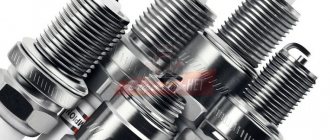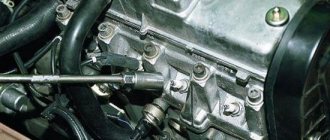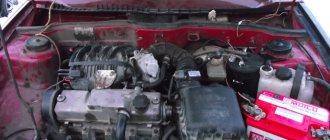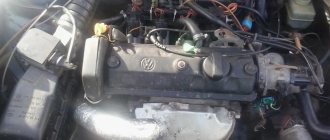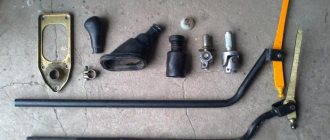Probably every car enthusiast has encountered such a problem when, after a short period of inactivity, the car suddenly refused to start. And there may be a dozen reasons for this. The most likely one is a dead battery. However, something else can happen - for example, the car stopped starting due to fuel getting on the spark plugs. And not only on carburetor cars, spark plugs are filled. VAZ-2110 (injector), Priora and many other cars are also not immune to this problem.
Even foreign cars are not an exception. That is why in today’s article we will look at why the spark plugs on the injector are flooded and how to fix this problem.
Causes
The most common of them is the incorrect operation of the car's electronic unit. What’s most interesting is that the spark plugs on the injector are filled more often in winter at subzero temperatures than in summer. And this is not an anomaly. There are objective reasons for this. As the temperature drops, mixing the fuel-air mixture becomes more difficult because a large amount of oxygen requires a large volume of gasoline in cold air. In this regard, the electronic control unit sends a signal to the fuel injectors, thereby increasing the amount of fluid supplied. This is the main reason why the candle floods.
What is happening in the engine at this moment? The injectors supply gasoline to the combustion chamber of the engine, while the starter tries to create the necessary compression in the cylinders, while at the same time trying to produce a spark to generate a flash. At the same time, we should not forget about the quality of our fuel - a lot of impurities and dirt significantly worsen the operation of the injectors, hence the corresponding troubles.
With ideal compression, the spark plugs can easily start even with a minimal impulse, but this only happens on new cars. Therefore, it fills spark plugs on the injector most often on cars more than 3-5 years old.
Spark present
If you are familiar with the situation when there is a spark, but the spark plugs are flooded, and the crankshaft rotates well from the starter. Here it is necessary to check the spark plugs themselves, despite the fact that there is a spark. This may not mean that it will always happen under pressure. Simply put, the spark will be on the unscrewed spark plug, but it may disappear after it is installed on the power unit. What causes this? In this case, the reason for this is the increase in pressure created during operation of the internal combustion engine. The best way to determine this is through diagnostics on a special stand.
Problem solving
How to fix this problem? The operating manual for modern cars says something like this: “If the spark plugs on the injector are flooded, you need to unscrew them and dry them thoroughly.” In this case, the starter must be cranked for 10-15 seconds after removing these elements. Next, the dried spark plugs are inserted back into their original place, and after that the engine starts. This is the way the car manufacturer offers us to fix the problem.
But there is another, popular, way to eliminate this problem. If you fill the spark plugs when they are cold (injector), before unscrewing and drying them, you should start the engine as follows. For injection internal combustion engines, the gas pedal is pressed to the floor all the way, the starter cranks the engine for about 10-15 seconds, then the pedal is released. In most cases, this helps to start the car. The essence of these manipulations is to blow air through the “wet” spark plugs (in this case, the fuel supply is completely shut off).
How to check the fuel system
Fuel system failures are also common in wet weather. Water can penetrate any gap and enter the injector connections, which spray gasoline into the combustion chamber and into the fuel tank through the fuel filler door O-ring. And even through the gasket of a submersible pump, which is installed directly into the tank.
Injectors are the easiest to diagnose. They are unscrewed and pulled out of the cylinder head. With the injector nozzles pointing away from the car, turn on the ignition for a few seconds, the pump will start and the injectors should start spraying gasoline. If the spray continues, everything is fine. Check the condition of the gasoline.
To test this, unscrew the wire to the injector rail and use a small, clean container to guide the end of the hose toward it. After turning on the pump, check the fuel level in the tank for a few seconds for the presence of water. If water appears in the fuel, the tank must be repaired. Drain the fuel mixture, let it dry completely and refill with clean fuel.
To avoid such damages, it is better to check the condition of the car and have it checked on time.
Each part of the power unit has a certain service life and must be replaced on time, otherwise the car owner will be caught in trouble.
What to do if the engine does not start after this?
In this case, these elements should be dried. In general, the spark plugs that go into injection engines are no different from those that are installed on carburetor engines, so the method described below can be considered universally applicable.
This method consists of the following. After unscrewing, the candles are cleaned with a special metal brush to remove accumulated carbon deposits, and then dried with a regular hairdryer. Alternatively, you can hold them over the burners of your gas stove. Next, the gap is checked, and the dried spark plugs are screwed back into place. In this case, the engine will definitely start at any temperature.
The oil pressure light came on
If your oil pressure warning light comes on while driving, you need to stop immediately. Further driving may result in serious engine damage. After stopping, perform the following diagnostics:
– check the oil level on the dipstick;
– it is possible that oil of inappropriate viscosity has been filled in - replace it;
– remove the oil pan and check the oil receiver mesh (may be clogged) and the pressure relief valve for distortion, clogging or weakening of the spring;
– inspect the fuel pump diaphragm - if it is damaged, gasoline enters the oil, thereby diluting it;
– check the oil pump - it may be faulty due to wear on the gears;
What to do if you fill the spark plugs on the injector every day?
It happens that gasoline gets there every morning. Of course, even the most patient car enthusiast will quickly get tired of carrying out such drying work every day, so in this situation we send the car for diagnostics. You can order this service at a service station, or you can do it yourself. In the latter option, you should diagnose the spark plugs for the quality of spark generation, its output from the ignition coil, check the cleanliness of the injectors and the operation of the Hall sensor. Perhaps the problem is hidden in one of these parts.
Causes of oil on spark plugs
If the candles are covered with oil, then first of all it is necessary to determine exactly which part has the most of it. Many car owners are faced with a situation where only the threads and body are coated with lubricant, while the electrodes are dry and have a normal color (light brown). But it also happens that the entire base ends up in oil.
At the same time, in addition to traces of lubricant on the spark plugs, a malfunction with the engine manifests itself in other ways - deterioration in dynamics, increased exhaust smoke, oil burns. In order for it not to be the cause, it must be eliminated.
Most often, the appearance of grease marks occurs due to wear and damage:
Under what conditions will the spark plugs not be filled with gasoline?
In order to avoid suddenly encountering a similar problem in the garage in the morning, you should always keep your car in good technical condition. Conditions that exclude the occurrence of this problem are:
- Defective starter.
- Well charged battery.
- Availability of high-quality spark plugs and high voltage wires.
- Timely cleaning and adjustment of fuel injectors. It is not recommended to use special additives in the tank for this. It is best to clean injectors using equipment designed for this purpose (in which case you can make such tools yourself). Floods spark plugs (VAZ-2110 - injector, among others) often for this very reason.
- Availability of high-quality gasoline. It is very difficult to find it at our gas stations, but to avoid trouble, find one gas station network that sells really high-quality gasoline, and constantly refuel there. Rest assured, the risks of premature contamination of the fuel system will be reduced tenfold.
Finally, we note another popular method of prevention. According to it, you should regularly (3-4 times a week) increase the engine speed to the red scale (4.5-5 thousand revolutions) for 10 seconds so that self-cleaning of carbon deposits in the combustion chamber of the internal combustion engine occurs.
Thus, we examined the factors of fuel formation in candles and learned ways to solve this problem.
Prevention
For normal operation of the ignition system, it is necessary to create certain conditions for the engine, especially in winter, under cold start conditions:
- before cold weather, change the spark plugs (it’s better to carry a good old set with you for replacement in case of filling), change the fuel filter, service the battery;
- monitor the battery charge, charge the battery;
- monitor the serviceability of the starter and prevent it from jamming;
- promptly, once every 100 thousand km, clean injection nozzles on a special stand;
- change the engine oil according to the regulations, if necessary, flush the lubrication system with decoking of the piston rings;
- regularly check the condition of the spark plugs, change them to platinum or iridium every 15-20 thousand km;
- choose high-quality gasoline with the maximum permissible octane number, keep the tank full in winter;
- Remember that prolonged operation of the engine in IAC, driving at low revs, at low speed, and insufficient engine warming up lead to carbon deposits. Drive onto highways, “spinning” the engine to 3500-5000 rpm so that carbon deposits and deposits burn out in the chamber and the spark plugs are cleaned.
Our dismantling shop offers high-quality spare parts for your car.
Go to search
Tags: fault diagnosis
Prevent candles from flooding
In order to prevent the spark plugs from flooding with gasoline, you need to maintain your car properly.
- the battery must always be charged;
- high-voltage wires are in good condition;
- Serviceable ignition coils;
- the injector nozzles are clean and working properly;
- fuel filter is clean.
If your car regularly does not start because the spark plugs are flooded, then the problem lies not in the spark plugs themselves, but in the computer, wiring or sensor.
If the car is flooded with 1 or 2 spark plugs, but the rest of the spark plugs are fine, the problem may be in the injectors, which, due to their poor performance, are unable to fill the rest of the spark plugs or in the computer.
It’s better to warm up your car in winter by spending a liter of gasoline than to unscrew flooded spark plugs in cold weather and waste your nerves and time. Car owners often share advice, which they often do not follow themselves, that the starter should be turned for no more than 10 seconds, otherwise the spark plugs will flood, so follow these simple rules and you will be happy.
How to avoid this
The time has come to tell you how the VAZ 2112 does not fill the candles:
- At subzero temperatures, gasoline and air cannot mix well, so it becomes more difficult to start the engine.
- To avoid flooding of spark plugs in such a situation, a number of preventive measures should be taken before the onset of frost.
- Before the onset of frost, the serviceability of the car starter is checked (see VAZ 2112: replacing the starter yourself)
- Be sure to install a new battery with the required power, or an old one after replacing the electrolyte and fully charging
- Always carefully monitor its charge level, especially when starting the car at sub-zero (low) temperatures
- To avoid flooding the spark plugs, the battery should be kept as charged as possible, and charged overnight if necessary.
- In addition, use high-quality oil suitable (recommended for winter) for the engine in winter
- It is worth monitoring the level of wear of the piston group of your car’s engine.
- Since with poor (low) engine compression, the chance of creating pressure by the pistons, which is necessary to create a concentrated mixture of gasoline and air, is very small
- Even when trying to start using towing, the spark plugs may flood
- Therefore, it is definitely recommended that you repair the engine before the cold weather
- Before winter comes, clean and adjust your injector or carburetor
- At the same time, try to refuel the car exclusively with proven fuel of good quality.
- When you are not sure about the correct choice, you should consult a specialist or ask for recommendations from familiar motorists
- If you start your car in the cold, you should put a load on your battery for a while
- Then turn it off and wait a few minutes
- Then carefully crank the engine with the starter.
- If the first start is unsuccessful (in the first 15 seconds), then wait a long time (5-10 minutes) and try again, this is done to avoid flooding the spark plugs
- To avoid complications, we recommend using a simple but very effective method: remove the battery at night and take it to a warm room
- It is imperative to use only high-quality candles
- Remember that a loudly advertised brand does not always mean good product quality
- You should consult with specialists whom you trust, or experienced motorists who use the same brand of car
- In addition, today advice on any problem can be obtained on the Internet at various thematic forums
- Now there are many additives that make it easier to start the engine; in cold weather you can use one for oil and one for fuel, the price of the additive is worth the saved nerves and time in the cold
In addition to this article, I suggest watching a training video.
Symptoms and mechanism of flooding
When it comes to flooded spark plugs, it does not matter what we are dealing with: a carburetor or an injector. Both engine types are not protected from flooding. Its consequences are unpleasant because they do not allow the engine to start. At the same time, it may smell like gasoline, the starter may crank, but most importantly, traces of a foreign substance can be easily detected on the spark plugs themselves: gasoline, oil or carbon deposits. To assess the condition of the spark plugs, they must be unscrewed.
The filling mechanism is quite simple. The fuel supplied to operate the engine does not ignite. The spark plugs get wet, and this prevents the engine from starting normally.
What are they doing to prevent this from happening?
The most important thing in this case is to ensure the proper technical condition of the engine systems
First of all, pay attention to the condition of the battery. Topping up with distilled water doesn't end there.
It should be charged and the charge level checked regularly. For areas with low temperatures in winter, the use of insulated battery covers is recommended. They can be purchased at automotive stores or made yourself. In very severe frosts, it is best to remove the battery from the car and bring it into a warm room.
Battery cover to keep the battery charged in cold weather.
The starter must be in perfect condition. If there are problems in it, then even with a fully charged battery it is impossible to start the engine. The battery's energy will be taken by a faulty starter, so it will not be enough to produce a high-quality spark.
On used injection engines, you need to regularly clean the injectors. Experts do not recommend performing surgery using additives added to gasoline. The desired effect is obtained after using the appropriate equipment, which some craftsmen make themselves.
Finally, I would like to give advice from experienced drivers. Periodically clean the spark plugs by driving at high speeds. It is enough to drive a certain distance at a speed of 110-120 km/h for self-cleaning to occur.
Features of starting a car in cold periods
In cold weather, before starting, you must first load the battery, then disconnect it for a while. After waiting a few minutes, you can try turning the starter to start the engine. If you fail to start the car on the first try, then in order not to fill the injector, you must wait a few more minutes. If all preventive measures were carried out in full before the frost, then there should be no problems with filling fuel.
We can list several conditions that are considered optimal for normal operation of the injector:
- presence of a working starter;
- maximum battery charge. The battery is powerful and in good condition;
- seasonal lubricant is used;
- spark plugs and high voltage electrical circuits must be in perfect condition;
- clean, adjusted nozzles are installed;
- The gas tank is filled with high-quality fuel.
There is an opinion among experienced drivers that driving a car along a highway at a speed of 120 km/h promotes self-cleaning of automobile systems, including the fuel system. You can also run the engine at 5000 rpm for about 10 minutes in the morning. The effect is similar to racing on a track.
It is believed that when high pressure is created in the systems, self-cleaning occurs. These measures can only be carried out if the car is in good condition and a significant increase in pressure in the systems will not harm it.
What steps do you need to take to get started?
The question arises, what to do if the car is not old, all systems are in order, but in the cold it refuses to start? When turning the spark plugs out, it turns out that they are wet. As already mentioned, in the cold season, the cause of this phenomenon may be weak compression, low-quality fuel or a weak battery.
Let's look again at the manufacturer's instructions. The book on car operation defines the following algorithm of actions:
- Turn out the spark plugs.
- Wipe them thoroughly and dry them.
- Run the starter for a few seconds.
- Put everything in place.
Often, car owners clean the injector using various fuel additives. This is not recommended at all, firstly, the quality of the fuel mixture is lost, which negatively affects the operation of the entire piston group, and secondly, the injector should be cleaned using special equipment.
Experienced drivers carry several sets of spare spark plugs with them. The quality of the spark produced depends on the technical characteristics of this ignition component. There is no point in saving on candles, their cost is not that high, and low-quality candles can cause a lot of problems.



